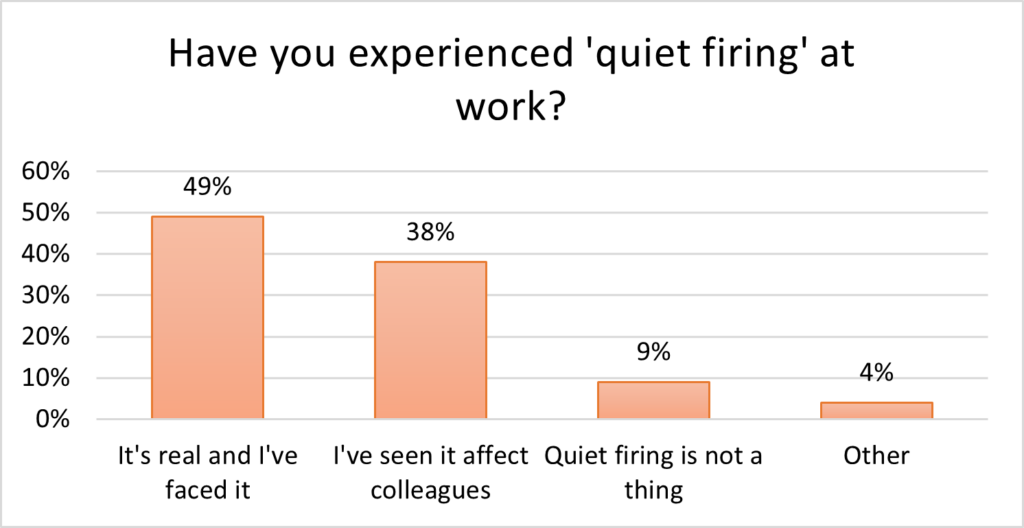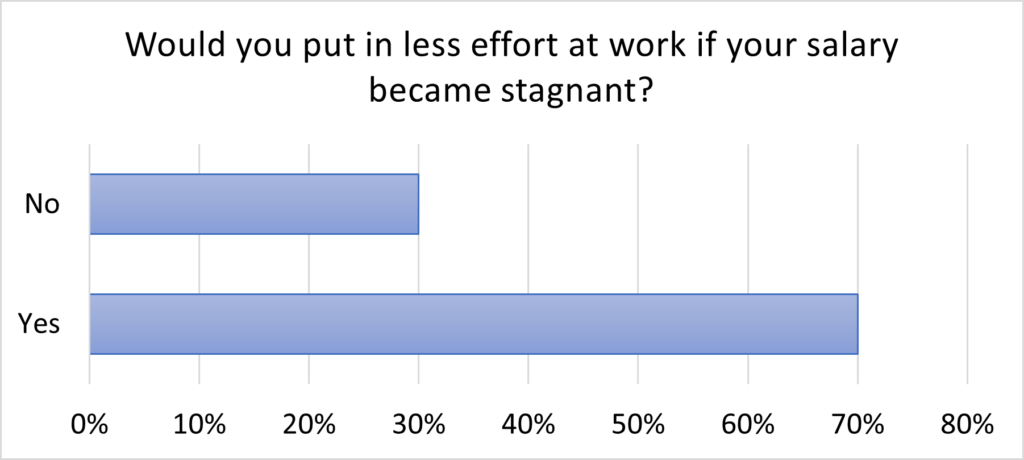Quiet quitting has gained prominence. But, it hides a more pernicious trend: Quiet Firing. Quiet Firing involves the employer treading workers so badly that they either quit or mentally check out from the job. It can be inadvertent. But, in extreme cases it can be passive aggressive bullying. Regardless of the cause, quiet firing reduces productivity and morale. This harms shareholders, making quiet firing bad for both companies and employees.
Much like quiet quitting, quiet firing is a new term for an old phenomenon. Indeed, a LinkedIn poll of more than 5,000 people reveals that 49% have been quiet fired and a further 38% have witnessed it.
Figure 1: Quiet firing poll responses
Source: LinkedIn Poll of 5037 people.

But, what might quiet firing involve? Why is it legally risky for employers? And what can employees do about it?
What does quiet firing involve?
Quiet firing involves treating an employee badly, potentially to encourage them to leave. It need not be intentional. It could be an unintentional side-effect of animus towards the employee.
In a large organization, quiet quitting can arise if a sub-manager so treats an employee, even if it is not company policy. In this respect, it has parallels to the issue of wage theft: it is not an excuse that it was unintentional or due to archaic IT.
Several specific situations are commonly associated with quiet firing.
- It can simply involve keeping wages stagnant or cutting them. This signals to employees that they should leave. This might merely reflect the company’s complacency or apathy rather than ill-will.
- Quiet firing can involve incorrectly rejecting promotions. Rightly rejecting a promotion is not quiet firing. But, confecting a reason to not promote someone or erroneously evaluating their performance could be. For example, if a manager says an employee has performed below-par when all quantitative metrics show otherwise, this can be quiet firing.
- It might involve making leave difficult or inconvenient to take. This can involve rejecting otherwise valid leave requests. Especially egregious cases can involve rejecting parental leave.
- It can involve retaliation. For example, adversely changing the nature, or amount, of work in retaliation for perceived slights can be quiet quitting.
Typically, quiet firing involves a confluence of these factors.
Why quiet firing is bad for employers
Quiet firing harms productivity and can be legally risky. It can arise because the firm is simply complacent or disrespectful. It can also arise because individual managers within firms behave poorly. However, even if the manager acts poorly, it still reflects negatively on the firm and the firm is still legally responsible for the manager’s behavior.
Worsened individual productivity: Quiet firing harms productivity. Individuals will likely ‘quiet quit’ the organization if they face quiet firing. This is because an individual’s utility (i.e., sense of well being) goes up with money and down with effort and risk, on average. But, quiet firing will reduce the worker’s expected income. Further, the psychological distress will increase the sense of effort. The fear of retaliation might also create more work-place risk. Therefore, the only way to maintain a semblance of wellbeing is to exert less physical effort in the face of stagnating job prospects. Further, the employee will likely psychology check out to reduce the perception of effort. This reduces productivity.
Figure 2: Response to stagnant wages
Poll response to whether workers would work less if wages remained stagnant. Source: LinkedIn poll by UNSW with 2383 responses.

Worsened team productivity: Quiet firing harms team morale and overall productivity. It does not merely affect the focal individual. This is because (a) the team will need to pick up any work the ‘quiet fired’ individual declines due to them checking out, (b) the team can see how the firm treats people; and thus, will be less loyal, and (c) it will become more difficult to recruit should information about the treatment become widely known.
The negative atmosphere will worsen the team’s perception of effort. It is analogous to pollution. Executives might demand more money to work in a polluted environment. Similarly, the reservation wage to work in a psychologically toxic environment is higher.
Legal risk: Quiet firing can constitute workplace bullying. If an employer specifically and repeatedly targets an individual, this could ground a bullying case. This will depend on the totality of the situation and multiple small infractions can add together to become bullying.
Example: Jill works for a large company. Karen is her direct manager. Jill goes for promotion but Karen gives Jill an incorrect performance evaluation, stating that Jill has under-performed when all quantitative metrics show otherwise. Jill then falls pregnant and requests parental leave. Karen initially tries to resist this. But, upon Jill complaining, Karen adversely adjusts Jill’s hours and work in a manner not obviously necessary due to workplace needs. Karen has also acted dismissively towards Jill. This situation would both involve quiet firing and could well constitute bullying.
How can companies prevent it?
Companies clearly lose from quiet firing. But, sometimes divisional managers act out of pettiness. This then harms the firm’s productivity. The firm can also be legally responsible for the manager’s behavior. This raises the question: what can firms do to prevent quiet firing? Simple solutions include:
- Introduce appropriate incentives and career progression paths. Inadvertent quiet firing occurs when those are not forthcoming. These should have clear guidelines and firms should take steps to minimize arbitrariness.
- Educate managers about how to motivate employees and about workplace bullying. This includes educating managers on the need to avoid nepotism, favoritism, and toxic behavior.
- Enhance oversight and appeals mechanisms. That is, empower employees to raise concerns if there is problematic behavior. Of course, companies should ensure due process in these mechanisms, and avoid merely acquiescing to vexatious complaints.
What can employees do about it?
Employees also lose from being stuck in a toxic environment. However, there are several rational responses. The appropriate response depends upon the situation.
Communication: If the quiet firing is merely due to the manager being negligent or unaware of how they are impacting workers, communication can be beneficial. Politely, but firmly, communicate your concerns. Human resources departments might also be able to assist with this.
Documentation: If the quiet firing rises to the level of bullying, you should methodically track all such incidents. Bullying can arise from a pattern of conduct. But, it is difficult to mount a bullying case without evidence. You should also clearly communicate concerns where possible. However, the risk of retaliation might make this easier said than done. Nevertheless, it is worth documenting all such incidents so that you can approach HR or escalate the concerns if relevant.
Strategic quiet quitting: The employee can quietly quit in this situation. It is best to do this strategically. As indicated, if there is no career upside, it is rational to exert less effort. However, this has risks. It can be psychologically demoralizing to be underappreciated and in a toxic environment. Further, future employers will look at your outputs when considering you for jobs. The employee should focus on activities that result in a clear demonstrable CV benefit. That is, focus on tasks that help your CV so that you can quit easily when a better job arises.
Moving on: Quiet firing is often best solved by moving jobs. This is unfortunate as the employee is being penalized for what might be the company’s or the manager’s fault. However, staying in a toxic work environment can be damaging. Moving on is best done when focusing on ticking CV-related boxes before leaving. If quiet quitting, consider spending that spare time building a skill or a side-hustle that has market value. Further, it can be useful to hunt for jobs well in advance before you reach breaking point and resign without a parachute.
Quiet firing is an unfortunate situation. It has existed for as long as there have been companies. But, harms companies. It can reduce productivity, which harms shareholders. It can also risk legal consequences. Employees also lose. Quiet firing imposes a psychological cost. Employees would rationally respond by quiet quitting, focusing on skill building, and leaving for greener pastures.
